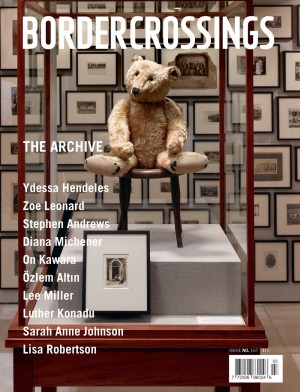Bill Burns
“Several species of small furry animals gathered together in a cave and grooving with a pict” is a song title from Pink Floyd’s 1969 album, Ummagumma. While I looked at Bill Burns’s exhibition, “Safety Gear for Small Animals,” this song kept creeping into my head. The song’s a collection of squeaks and chortles that build to a cacophony, at which point the Pict starts raving in a broad Scottish dialect. I don’t exactly see Bill sitting naked in a dark and damp cave, painted blue from head to toe, coming out occasionally to scare the hell out of the Romans, but I do have this image of small furry animals gathered at his feet, following him around the studio: their saviour.
“Safety Gear for Small Animals” brings together a body of work that has been at the centre of Bill Burns’s preoccupation/obsession for about 10 years. The conceptual framework of the show hangs on the construction of a corporate identity, the Safety Gear for Small Animals (SGSA) society, of which Burns is the director. The collection of works are the products generated as the society sets out to fulfil its mandate, to save the small animals of the world. The exhibition brochure states that “The largest safety gear for small animals producer in the world, SGSA is composed of several divisions, including, for instance: a safety gear prototype production division, conservation and relocation departments, a multimedia program, a publishing house, and an itinerant museum.” Like other art entity projects—General Idea, etoy and the Critical Art Ensemble come to mind—the organizational structure is aesthetisized, establishing a Formalist methodology with Modernist overtones of form as content. It’s a multi-layered endeavour incorporating a variety of bureaucratic models including the natural history museum, NGO non-profit societies and a kind of mad scientific research laboratory. The resulting work is charming, clever and topical. It’s also a bit of a joke but, like the humour of the court jester, the punchline carries a bite. The tongue-in-cheek underpinnings of this project mark out a difficult line to walk but Burns manages it, with only an occasional stagger.

Bill Burns, Artist as a Young Boy Taken by his Mother Emma Lecours Burns, c. 1963, from the exhibition “Safety Gear for Small Animals.” Courtesy Liane and Danny Taran Gallery, Montreal.
The SGSA makes small things for small beings: gloves, hard hats, prosthetics, etc. It’s an exercise in obsessive detail. Everything is perfectly miniaturized. The work pivots on this attention to detail and makes it clear that this is a serious business for serious times. We are inundated with bad news about the environment and we seem to be watching the complex mechanism of life on this planet slowly unravelling. It’s clear that humanity is having an irreversible impact on things. The SGSA lightens up the message by couching a very serious situation in a laugh. Things are a mess but that doesn’t mean there’s nothing to be done. Every individual can take an interest in the conditions of small animals and thereby become more aware of the condition of life in general. The popularity of television shows like the Kratt Brothers and the Crocodile Hunter speak to a need our culture has to interact with the animal world.
Mark Dion and Trevor Gould are other artists who have taken the natural history museum and the programmatic tendency of institutions to task by revealing their underlying power structures and agendas. Likewise within the SGSA, there is a hint at an overwhelming desire for control, and the mad scientist, or conservationist, gone wrong. The obsessive model building, the isolation necessary in the manufacturing and the prescriptive arrogance of the rescue program take us into the darker corners of human intention. By joining the ranks of the rescuers, you can assuage your guilt but you still may be playing a part in things going terribly wrong. This may be what Burns is getting at, pointing out the absurdity of the project and thereby holding a mirror up to our liberal, pseudo-conservationist need to be a good guy.
Culturally we see a proliferation of experts these days, people who know and can do things better than we can. Radical makeovers, home decorators and fashion consultants disempower individuals, putting the decisions into the hands of those who have set themselves up as authorities. While Burns encourages you to take part, get with his program and save a few animals, he also sets up his organization as the expert. Is this work a call for reforming our relationship to the environment or is it just an art strategy? Considering this question clouds my ability to look and I get the feeling that the small animals are gathering at my feet. I can hear them and feel the burden of responsibility that comes with each chirp and squeal. I don’t think I can face it. There’s Pink Floyd again, another song, the anxiety grows slowly as the tension builds, then the scream—Careful With That Axe Eugene! ■
“Safety Gear for Small Animals” was on exhibit at the Galerie Liane et Danny Taran in Montreal from April 22 to June 6, 2004.
Randall Anderson’s work has been exhibited and performed internationally. In 2004 his work was presented at The Atlantic Center for the Arts in Florida. He lives and works in Montreal.

